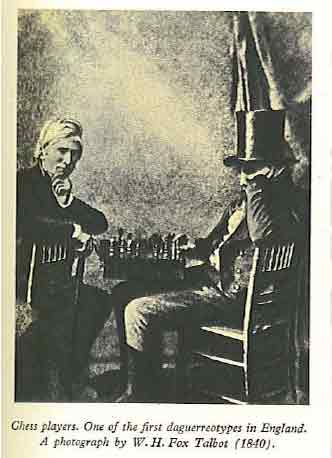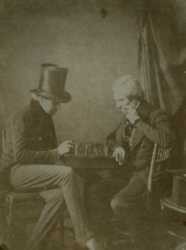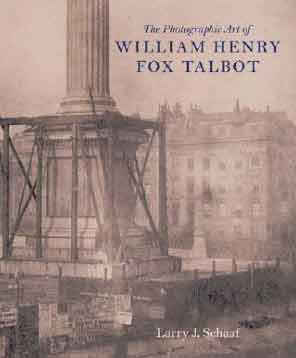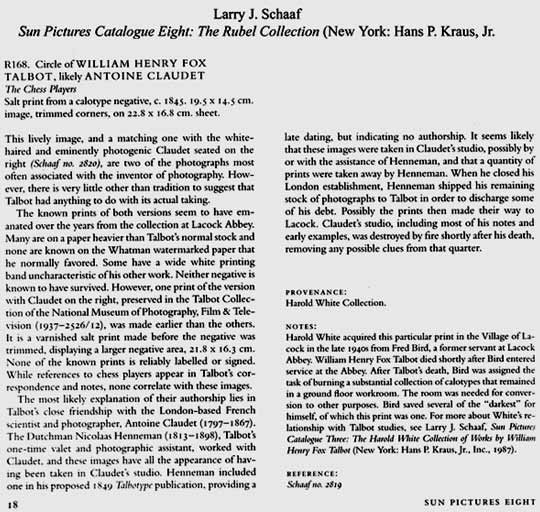|
The Chess Players
W. H. Fox Talbot
Which year, who and
what exactly is it?
Many chess historians take
photographs and authorities' research for granted but Lawrence Totaro,
always skeptical provides the following links (with analysis)
that have a
"photo" supposedly taken by W.H. Fox Talbot with different years as
follows:
1846
http://auden.hrc.utexas.edu/PhotoFiles/dbimages/talbot1.html
1844
http://www.scienceandsociety.co.uk/results.asp?image=10300039&wwwflag=2&imagepos=3
1840
http://www.chessgraphics.net/saz04.htm

A History of Chess
by Jerzy Gizcyki also mentions
the “photo” on page 39 with the date 1840.
(note that the caption refers
to the picture as a daguerreotype)
Now there are two very distinct versions of this
image, one with Claudet on the left (above) and a very different
pose with him on the right (below)

(The Sandor Family Collection,
Chess Players 1844)
http://culturalpolicy.uchicago.edu/conf2001/papers/sandor.html
After jumbling through several sites, Lawrence would
personally like to thank Dr. Larry J. Schaaf, both Director of The Talbot
Correspondence Project at DeMontfort University in Leicester (
http://foxtalbot.dmu.ac.uk
) and Catalogue Raisonne
project at The University of the Arts London (
http://www.foxtalbot.arts.ac.uk)
for expounding on this matter.
Dr. Schaaf writes:
Thank you for your note, for this image is one
of perennial interest. I can tell you for sure that it is a salt print
made from a calotype negative (not a Daguerreotype). There are two
closely related versions of this, one with Claudet on the right, the
other with him on the left - he has the white hair. The other chap is
not identified. There is no certain dating. Although Talbot did take
pictures of people playing chess, in my opinion this is not one of
them. There is in fact absolutely nothing to associate it with Talbot.
My personal opinion is that it was done in the studio of Antoine
Claudet, either as a self-portrait (done by one of his operators) of
just possibly when he was teaching Nicolas Henneman. I've attached a
catalogue entry I did some years ago that will explain this briefly.
best of luck in your research
Larry J. Schaaf
Mr. Schaaf goes on to write:
One of the problems, of course, is that legends get
established and then repeated over and over - when this image first
came to public attention around the 1970s, not many early
photographers were known besides Talbot, and somebody made the
assumption that it must have been done by him - from there, a likely
date was postulated, and off we go... I'm hoping some day that an
authority in that field (chess field) will be able to tease out some
clues, either from these pictures, or from Talbot's own chess player
picture A "salt print" is a modern term, not from Talbot's day His
photogenic drawing process (realized in 1834 - he only had the idea
whilst in Italy in 1833) was a "salt print" - but it naturally
produced a negative - the same material was used to make the negative
(either by contact under a leaf &c or in the camera) - another sheet
of the same material was placed under the negative to make the print -
it was a negative of a negative, hence a positive print - the
distinction here is that it was a printout, rather than a developing
process - in a camera, it would have been far far too slow to make a
chess portrait The calotype (introduced 1841) was a negative process
that used a short exposure to record an invisible latent image that
was subsequently developed in chemistry to make it visible - this
developer "amplified" the original effect of the exposure in the
camera and permitted exposure times in the low seconds - in principle,
this is the same as modern films The calotype negative was printed by
contact on Talbot's original photogenic drawing paper (salt print) -
this made a negative of a negative, hence a positive So, while people
loosely call the prints they are looking at Calotypes, what they are
really seeing is a photogenic drawing print (salt print) taken from a
calotype (developed) negative.
Regarding the two photos, Dr. Schaaf finishes:
The two versions were obviously taken at the same time and almost
certainly by the same photographer.

http://www.amazon.com/Photographic-William-Henry-Fox-Talbot/dp/0691050007/sr=8-3/qid=1162581977/ref=sr_1_3/103-6091255-0230258?ie=UTF8&s=books
For future researchers who wish to use this print, it
would be advisable to include that according to Dr. Larry J Schaaf
this salt print taken from a calotype negative is not from Talbot as
previously thought, but in Antoine Claudet’s studio by or assisted with
the Dutchman, Nicolas Henneman (1813-1898) and that the date is unknown.

Anyone with comments or suggestion please e-mail Mr.
Lawrence Totaro
lasker27@hotail.com or Dr.
Larry J Schaaf
l.schaaf@arts.ac.uk
Archives |

